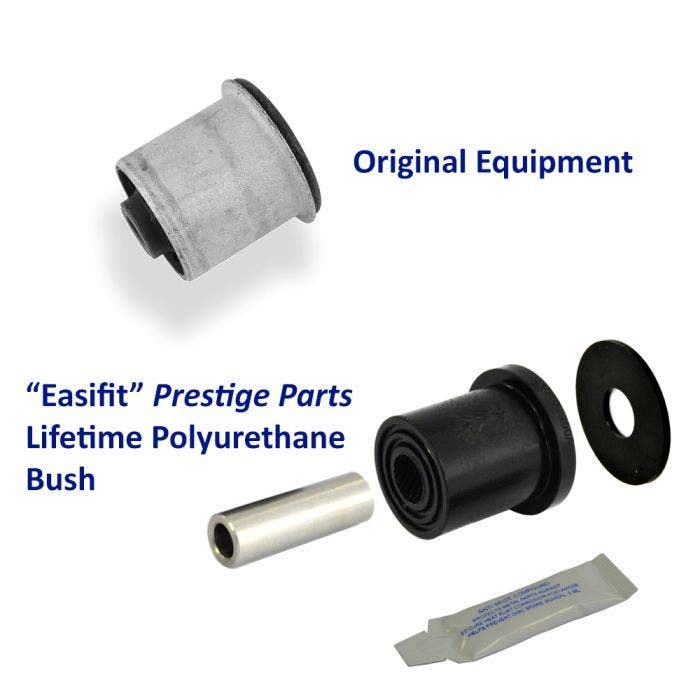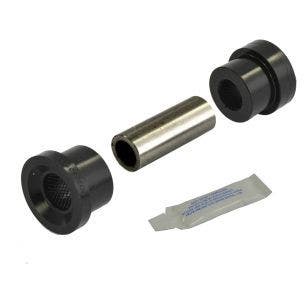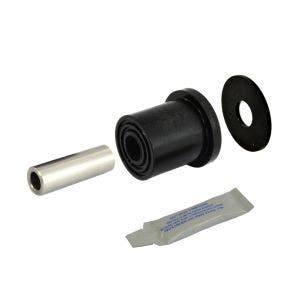Introducing our new Polyurethane Bush Kit range for Rolls-Royce Silver Seraph and early Bentley Arnage series
John Tupper (IntroCar's MD) introduces our new polyurethane bush kits for Rolls Royce Silver Seraph and early Bentley Arnage series. From how easy is to install them, to why we've labelled them 'lifetime' bushes!
This new range of suspension bushes are for the Rolls-Royce Silver Seraph and the early Bentley Arnage series which includes the Green Label, the Red Label and also the Birkin and Le Mans models. Currently it does not apply to the later Arnage R, Arnage T, Brooklyn and Azure but we are working on those too.
These bushes are quite different in design from the originals, the notable difference being that these newly manufactured ones are a polyurethane material whereas the bushing in the originals is rubber.
| Description | Part Number |
| Upper Suspension Arm Bush Kit (Leading & Trailing) | 3Y0407200APL-X |
| Front Lower Lever Bush Kit (Trailing) | PD30984PAPL-X |
| Front Lower Lever Bush Kit (Leading) | PD30985PAPL-X |


Why we need to replace suspension bush kits on Rolls-Royce & Bentley cars?
Anyone who has driven these Rolls-Royce Silver Seraph and early Bentley Arnage series cars for a long period of time or worked on them will know that they go through suspension bushings. The reason for that is simple, these cars are very heavy - actually the heaviest car produced by Rolls-Royce motor cars weighing in at just under three tonnes for standard version. So a heavy car equals heavy use of suspension components.. it's just how it is!
How do the bushes work?
The original bushes are formed, as you can see in the video, by two tubes, an outer tube and an inner tube and then a rubber or a polymer which is probably a synthetic rubber material of some sort.
The way these function is that as the suspension operates, you can see the arm is moving up and down or slightly backwards and forwards, this is moving this bush, this inner tube which is bonded to the rubber which is also bonded to the outer tube is moving in opposition so it's twisting like that and it is also moving in and out. So there are what they call axial and radial forces at work. So effectively what happens is the bush will be doing that, through all of its use.
So it is 'in and out' and 'in and out' repeatedly. In fact, if you were to actually map any point on this rubber material you would actually see that it travels quite a long way as it moves in and out.
With these, as the suspension operates, the molecules that are in this synthetic rubber are being continuously stretched and relaxed and stretched and relaxed and actually the energy that is absorbed by these is actually converted into heat. And one of the things that is quite interesting is if you put one of these in a lab and you repeatedly put it under pressure either vertically or laterally you will actually see that the performance of the rubber actually degrades as heat gets into the material and it becomes more or less softer.
Now eventually the molecules in this bonding material break down and typically the bush fails. Either the rubber bush will split or more likely the bonding between the inner tube and the and the bush will separate. So that is generally the reason that they fail.
What is different about the polyurethane bush?
The first thing is that there is no outer tube as it doesn't need one. The second is that the inner tube is separate, it's not bonded, and so what actually happens is that this remains relatively static within the arm and instead rotates so that there isn't any twisting or stretching of this material.
Secondly there is no outer bush which you have to press in. There are some advantages to polyurethane. The first thing is that polyurethane in itself actually lasts longer than rubber or synthetic rubber. Rubber materials tend to leach some of the compounds in the mixture into the atmosphere over time so even if you had a car that not done any miles the suspension will still have degraded substantially over a period of time if it was left and that is simply because the rubber material itself would have degraded to some degree from when it was originally made. Polyurethane doesn't suffer from that and not only that it tends to be better at dealing with ozone and also with oils and other things that tend to degrade rubber components.
Also, because the tube swivels freely you don't get this problem with bonding breaking down or materials having to do lots of extra work.
What are the advantages of using these suspension bushes?
AS these tend to last longer, we call them 'lifetime' bushes because generally speaking you expect these to last, we hope, somewhere near the lifetime of the car. The other massive advantage is that these are a lot easier to fit. To make sure that it the originals fit correctly and in parallel there is a set of special tools and it is quite a difficult job.
This polyurethane version of in comparison can be tapped in with a rubber mallet so there is no tooling required. Then once they are tapped in there is lubrication applied and this can just be slid in afterwards and then you can bolt up using the normal procedures for the car.
If you are interested in finding out more about this then there is a lot more detail on the website. If you go to the Arnage section and go to any of these part numbers there is a set of instructions, a user guide and also more information.
We look forward to people using these and trying them. They're certainly on our car and can tell you that it really has been quite a transformation! Any questions, let us know!




